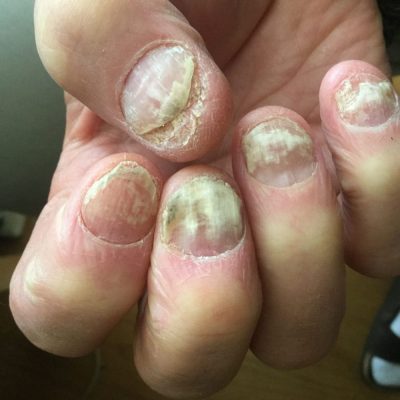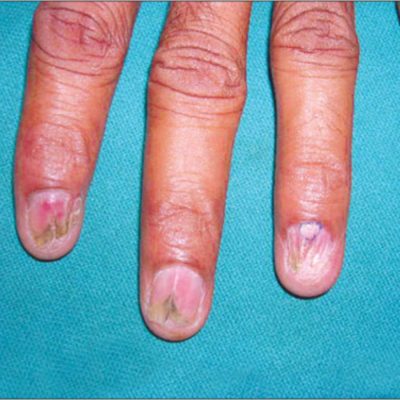Nail Lichen Planus
Nail lichen planus is an inflammatory condition affecting the nails, leading to changes in their appearance and structure. It is a variant of lichen planus which is a chronic autoimmune disorder that can impact the hair, skin, nails and mucous membranes. Proper diagnosis and management are essential to prevent permanent nail damage and to alleviate discomfort.

What is Nail Lichen Planus?
Nail lichen planus is a rare condition primarily affecting the fingernails and toenails. It can lead to a range of nail abnormalities, and if left untreated, can result in permanent nail loss or scarring. It can occur independently on the nails only, or manifest along with other forms of lichen planus.
Symptoms of Nail Lichen Planus
A range of symptoms are associated with nail lichen planus, which may vary in severity. Some common symptoms include
Ridges & Grooves
You may find longitudinal ridging or grooving on the nail surface.
Nail Thinning
Nails may become thinner and more fragile, making them prone to splitting or breaking.
Splitting & Fissures
Deep grooves or fissures may form in the nails, leading to splitting and pain.
Onycholysis
This is where the nail gets detached from the nail bed, causing discomfort and an increase in the risk of infection.
Pterygium Formation
A characteristic feature of nail lichen planus is the formation of a scar-like band of tissue called pterygium, which extends from the base of the nail and if left untreated, can lead to permanent nail loss.
Discoloration
Affected nails may appear discoloured, often turning yellow, brown or red.
Causes of Nail Lichen Planus
The exact cause of nail lichen planus is not fully understood, but it is believed to be of multifactorial causes.
An overactive immune system attacks the nail matrix, leading to inflammation and other subsequent symptoms.
A family history of autoimmune disorders may increase the risk of developing nail lichen planus.
Factors such as stress, nail injuries, viral infections or some medications, may exacerbate the condition or trigger a flare-up.

Diagnosis of Nail Lichen Planus
A comprehensive evaluation by a dermatologist is required to diagnose nail lichen planus. A doctor will examine the nails for characteristic signs of nail lichen planus. The patient’s medical and family history will be taken to assess the likelihood of nail lichen planus. At times, a nail biopsy may be performed to rule out other similar conditions or to confirm the diagnosis.
Management and Treatment of Nail Lichen Planus
Nail lichen planus can be a challenging condition to treat. Early intervention is vital to prevent permanent nail damage. SkinAccess Clinics offers a range of treatment options to help manage your condition effectively.
➥ Topical Treatments:
- Corticosteroids: They can be applied directly to the nails and surrounding skin to reduce inflammation and slow the progression of nail damage. At times, it may need to be directly injected into the nail matrix.
- Tacrolimus: This is an immunosuppressant. It helps by reducing the immune system activity and managing inflammation.
➥ Systemic Medications:
- Oral Corticosteroids: These may be prescribed for severe cases. They help to reduce inflammation and prevent further nail damage.
- Immunosuppressants: These may be used to help suppress the immune system and control the symptoms of nail lichen planus.
➥ Psoralen & Ultraviolet A (PUVA) Phototherapy: This combines a light-sensitizing medication with controlled UVA light exposure.
➥ Nail Care & Lifestyle Modifications:
- Gentle Nail Care: To protect the nails and reduce discomfort, you should keep your nails short, avoid nail trauma and moisturize regularly.
- Avoiding Triggers: Identifying and avoiding certain triggers like stress or certain medications, can help prevent the condition from flaring up
➥ Surgical Intervention: In cases where pterygium formation leads to severe nail deformity or pain, nail surgery may be necessary to remove the affected nail tissue.
Conclusion
Nail lichen planus is quite a complex condition requiring careful diagnosis and management to prevent long-term complications. At SkinAccess Clinics, we provide comprehensive care and personalized treatment plans to help manage symptoms and improve nail health. If you are experiencing symptoms of nail lichen planus, schedule a consultation with us today to explore your treatment options and take steps toward healthier nails!
